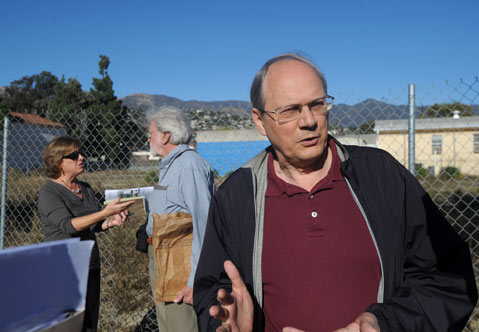‘Height Shock’ for Haley Street?
Low-Rent Housing Trumps Neighbor's Objection

What was either trumpeted — or reviled — as a “first of its kind” low-income rental housing development slated for Haley and Salsipuedes streets got the green light from the Santa Barbara City Council last week despite the vigorous objections of a nearby property owner who complained the three-story, 40-apartment project would be way too big for the neighborhood. Though the vote was 6-1 in favor of the housing project — and against the appeal — the outcome was much closer than the split might suggest. Most councilmembers emphatically agreed the project promised exactly what the city needs — seriously affordable rental housing — but many had second thoughts about the project’s size and mass, not to mention the path by which it got in front of them.
Peoples’ Self-Help Housing Corporation is proposing to build 40 subsidized family apartments — ranging in rent from only $500 to $1,000 a month, well below market rates — by availing itself to a brand new zoning tool known in bureaucratic lingo as “AUD” which stands for the equally impenetrable “Average Unit Density.” The AUD is designed to encourage developers to build lower-cost rental housing by allowing them to build more — though smaller — units than traditional zoning would allow and without the encumbrances of traditional parking requirements.
Under the new scheme, such housing projects are to be decided by the city’s Architectural Board of Review, which traditionally fixates on design details and not parking sufficiency or flood-plain issues. In this case, the Haley Street development went before the ABR three times before securing a 3-2 approval. Initially, the plans called for a four-story structure with 47 units and 47 parking spaces. But in response to concerns over size — raised by White’s Pet Hospital owner Arthur Posch and several ABR members — architect Detlev Peikert agreed to lop off the fourth story and its seven units.
While that change proved compelling to the council, Posch remained decidedly unimpressed. How could such a seemingly dramatic concession, he demanded, yield such a meager reduction in overall height by only three feet? Posch also called into question the amount of toxic chemicals buried in the soil, predicting when the rains hit, the area — only a few feet above sea level — would be awash in chemically tainted waters. Five feet of dirty soil, it turns out, had been scraped off the site with three feet of clean dirt taking its place. As for flooding, the development was designed to withstand a 100-year event.
Councilmembers were concerned about the parking impacts the housing project could have on the neighborhood. With only one space required per household — to hold down costs — traffic planners predicted residents or visitors would park on nearby streets. But councilmembers were also assured in how tenants at similar downtown housing projects used only a fraction — on average two-thirds — of their available parking spaces. Cars, it turns out, are simply too expensive for many people who could qualify for such housing.
But the dominant debate was size versus affordability. Councilmember Cathy Murillo first proclaimed the city’s negligible vacancy as being “brutal,” adding, “And I’ve lived through it.” Then she expressed concern about “height shock,” asking, “Will that corner shock people?” Although Murillo would vote for the project, her answer to her own question was equivocal. “For what I can tell, I think it will be okay.” Councilmember Randy Rowse worried whether projects following suit might lead to the “canyonization” of Haley Street. Councilmember Dale Francisco argued the project should be sent back to the ABR with instruction to lower the building front further. When it appeared Councilmember Bendy White would support that, Mayor Helene Schneider, who normally waits until all councilmembers speak first, uncharacteristically jumped in. “This is what we need,” she argued, reminding her colleagues that the AUD emerged out of nine grueling years of debate over density and affordability. To send it back would send the wrong message to other developers exploring ways to give City Hall what it asked for.
Everyone agreed that the Planning Commission should weigh in on similar projects in the future and that story poles would have served the decision makers and public better than the 3-d rendering provide by the architect. In the meantime, Posch is weighing his options whether to sue.



